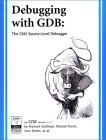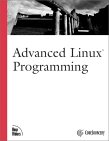本文共 14637 字,大约阅读时间需要 48 分钟。
GDB Command Line Arguments:
Starting GDB:
- gdb name-of-executable
- gdb -e name-of-executable -c name-of-core-file
- gdb name-of-executable -pid process-id (Use ps -auxw to list process id's.)
Command line options: (version 6. Older versions use a single "-")
-
Option Description --help-h List command line arguments --exec=file-name-e file-name Identify executable associated with core file. --core=name-of-core-file-c name-of-core-file Specify core file. --command=command-file-x command-file File listing GDB commands to perform. Good for automating set-up. --directory=directory-d directory Add directory to the path to search for source files. --cd=directory Run GDB using specified directory as the current working directory. --nx-n Do not execute commands from ~/.gdbinit initialization file. Default is to look at this file and execute the list of commands. --batch -x command-file Run in batch (not interactive) mode. Execute commands from file. Requires -x option. --symbols=file-name-s file-name Read symbol table from file file. --write Enable writing into executable and core files. --quiet-q Do not print the introductory and copyright messages. --tty=device Specify device for running program's standard input and output. --pid=process-id-p process-id-c process-id Specify process ID number to attach to.
| GDB Commands: |
Commands used within GDB:
-
Command Description help List gdb command topics. help topic-classes List gdb command within class. help command Command description. apropos search-word Search for commands and command topics containing search-word. info argsi args List program command line arguments info breakpoints List breakpoints info break List breakpoint numbers. info break breakpoint-number List info about specific breakpoint. info watchpoints List breakpoints info registers List registers in use info threads List threads in use info set List set-able option Break and Watch break funtion-namebreak line-number Suspend program at specified function of line number. break +offsetbreak -offset Set a breakpoint specified number of lines forward or back from the position at which execution stopped. break filename:function Don't specify path, just the file name and function name. break filename:line-number Don't specify path, just the file name and line number. break *address Suspend processing at an instruction address. Used when you do not have source. break line-number if condition Where condition is an expression. i.e. x > 5Suspend when boolean expression is true. break line thread thread-number Break in thread at specified line number. Use info threads to display thread numbers. tbreak Temporary break. Break once only. Break is then removed. See "break" above for options. watch condition Suspend processing when condition is met. i.e. x > 5 clearclear functionclear line-number Delete breakpoints as identified by command option. deleted Delete all breakpoints, watchpoints, or catchpoints. delete breakpoint-numberdelete range Delete the breakpoints, watchpoints, or catchpoints of the breakpoint ranges specified as arguments. disable breakpoint-number-or-rangeenable breakpoint-number-or-range Does not delete breakpoints. Just enables/disables them.Example:Show breakpoints: info breakDisable: disable 2-9 enable breakpoint-number once Enables once continuec Continue executing until next break point/watchpoint. continue number Continue but ignore current breakpoint number times. Usefull for breakpoints within a loop. finish Continue to end of function. Line Execution stepsstep number-of-steps-to-perform Step to next line of code. Will step into a function. nextnnext number Execute next line of code. Will not enter functions. untiluntil line-number Continue processing until you reacha aspecified line number. Also: function name, address, filename:function or filename:line-number. stepisinextini step/next assembly/processor instruction. info signalsinfo handlehandle SIGNAL-NAME option Perform the following option when signal recieved: nostop, stop, print, noprint, pass/noignore or nopass/ignore where Shows current line number and which function you are in. Stack backtracebtbt inner-function-nesting-depthbt -outer-function-nesting-depth Show trace of where you are currently. Which functions you are in. Prints stack backtrace. backtrace full Print values of local variables. frame numberf number Select frame number. up numberdown number Move up/down the specified number of frames in the stack. info frame List address, language, address of arguments/local variables and which registers were saved in frame. info argsinfo localsinfo catch Info arguments of selected frame, local variables and exception handlers. Source Code listllist line-numberlist functionlist -list start#,end#list filename:function List source code. set listsize countshow listsize Number of lines listed when list command given. directory directory-namedir directory-nameshow directories Add specified directory to front of source code path. directory Clear sourcepath when nothing specified. Examine Variables print variable-namep variable-namep file-name::variable-namep 'file-name'::variable-name Print value stored in variable. p *array-variable@length Print first # values of array specified by length. Good for pointers to dynamicaly allocated memory. p/x variable Print as integer variable in hex. p/d variable Print variable as a signed integer. p/u variable Print variable as a un-signed integer. p/o variable Print variable as a octal. p/t variablex/b addressx/b &variable Print as integer value in binary. (1 byte/8bits) p/c variable Print integer as character. p/f variable Print variable as floating point number. p/a variable Print as a hex address. x/w addressx/4b &variable Print binary representation of 4 bytes (1 32 bit word) of memory pointed to by address. GDB Modes set gdb-option value Set a GDB option set logging onset logging offshow loggingset logging file log-file Turn on/off logging. Default name of file is gdb.txt set print array onset print array offshow print array Default is off. Convient readable format for arrays turned on/off. set print array-indexes onset print array-indexes offshow print array-indexes Default off. Print index of array elements. set print pretty onset print pretty offshow print pretty Format printing of C structures. set print union onset print union offshow print union Default is on. Print C unions. set print demangle onset print demangle offshow print demangle Default on. Controls printing of C++ names. Start and Stop runrrun command-line-argumentsrun < infile > outfile Start program execution from the beginning of the program. The command break main will get you started. Also allows basic I/O redirection. continuec Continue execution to next break point. kill Stop program execution. quitq Exit GDB debugger.
| GDB Operation: |
- Compile with the "-g" option (for most GNU and Intel compilers) which generates added information in the object code so the debugger can match a line of source code with the step of execution.
- Do not use compiler optimization directive such as "-O" or "-O2" which rearrange computing operations to gain speed as this reordering will not match the order of execution in the source code and it may be impossible to follow.
- control+c: Stop execution. It can stop program anywhere, in your source or a C library or anywhere.
- To execute a shell command: ! command or shell command
- GDB command completion: Use TAB key info bre + TAB will complete the command resulting in info breakpoints Press TAB twice to see all available options if more than one option is available or type "M-?" + RETURN.
- GDB command abreviation: info bre + RETURN will work as bre is a valid abreviation for breakpoints
| De-Referencing STL Containers: |
Displaying STL container classes using the GDB "p variable-name" results in an cryptic display of template definitions and pointers. Use the following ~/. file (V1.03 09/15/08). Now works with GDB 4.3+.
(Archived versions: [ GDB 6.4+ only]) Thanks to for permission to post this script.Use the following commands provided by the script:
-
Where T refers to native C++ data types. While classes and other STL data types will work with the STL container classes, this de-reference tool may not handle non-native types.Data type GDB command std::vector<T> pvector stl_variable std::list<T> plist stl_variable T std::map<T,T> pmap stl_variable std::multimap<T,T> pmap stl_variable std::set<T> pset stl_variable T std::multiset<T> pset stl_variable std::deque<T> pdequeue stl_variable std::stack<T> pstack stl_variable std::queue<T> pqueue stl_variable std::priority_queue<T> ppqueue stl_variable std::bitset<n>td> pbitset stl_variable std::string pstring stl_variable std::widestring pwstring stl_variable
Also see the .
| De-Referencing a vector: |
Example: STL_vector_int.cpp
-
Compile: g++ -g STL_vector_int.cpp#include
#include #include using namespace std; main() { vector II; II.push_back(10); II.push_back(20); II.push_back(30); cout << II.size() << endl; }
Debug in GDB: gdb a.out
-
Notice the native GDB print "p" results in an cryptic display while the "pvector" routine from the GDB script provided a human decipherable display of your data.(gdb) l 1 #include 2 #include 3 #include 4 5 using namespace std; 6 7 main() 8 { 9 vector II; 10 (gdb) l 11 II.push_back(10); 12 II.push_back(20); 13 II.push_back(30); 14 15 cout << II.size() << endl; 16 17 } (gdb) break 15 Breakpoint 1 at 0x8048848: file STL_vector_int.cpp, line 15. (gdb) r Starting program: /home/userx/a.out Breakpoint 1, main () at STL_vector_int.cpp:15 15 cout << II.size() << endl; (gdb) p II $1 = { >> = { _M_impl = { > = { <__gnu_cxx::new_allocator> = {}, }, members of std::_Vector_base >::_Vector_impl: _M_start = 0x804b028, _M_finish = 0x804b034, _M_end_of_storage = 0x804b038 } }, } (gdb) pvector II elem[0]: $2 = 10 elem[1]: $3 = 20 elem[2]: $4 = 30 Vector size = 3 Vector capacity = 4 Element type = int * (gdb) c Continuing. 3 Program exited normally. (gdb) quit
| De-Referencing a 2-D vector of vectors: |
Example: STL_vector_int_2.cpp
-
Compile: g++ -g STL_vector_int_2.cpp#include
#include using namespace std; main() { vector< vector > vI2Matrix(3, vector(2,0)); vI2Matrix[0][0] = 0; vI2Matrix[0][1] = 1; vI2Matrix[1][0] = 10; vI2Matrix[1][1] = 11; vI2Matrix[2][0] = 20; vI2Matrix[2][1] = 21; cout << "Loop by index:" << endl; int ii, jj; for(ii=0; ii < 3; ii++) { for(jj=0; jj < 2; jj++) { cout << vI2Matrix[ii][jj] << endl; } } }
Debug in GDB: gdb a.out
-
Note "pvector" does not de-reference the entire vector of vectors all at once but returns vectors $1, $2 and $3. The "pvector" command then helps us traverse the information by examining the contents of each element in the individual "terminal" vectors. Note that the native gdb "p vI2Matrix" (last command) was much less informative.(gdb) l 1 #include 2 #include 3 4 using namespace std; 5 6 main() 7 { 8 vector< vector > vI2Matrix(3, vector(2,0)); 9 10 vI2Matrix[0][0] = 0; (gdb) l 11 vI2Matrix[0][1] = 1; 12 vI2Matrix[1][0] = 10; 13 vI2Matrix[1][1] = 11; 14 vI2Matrix[2][0] = 20; 15 vI2Matrix[2][1] = 21; 16 17 cout << "Loop by index:" << endl; 18 19 int ii, jj; 20 for(ii=0; ii < 3; ii++) (gdb) break 17 Breakpoint 1 at 0x8048a19: file STL_vector_2.cpp, line 17. (gdb) r Starting program: /home/userx/a.out Breakpoint 1, main () at STL_vector_2.cpp:17 17 cout << "Loop by index:" << endl; (gdb) pvector vI2Matrix elem[0]: $1 = { >> = { _M_impl = { > = { <__gnu_cxx::new_allocator> = {}, }, members of std::_Vector_base >::_Vector_impl: _M_start = 0x804b040, _M_finish = 0x804b048, _M_end_of_storage = 0x804b048 } }, } elem[1]: $2 = { >> = { _M_impl = { > = { <__gnu_cxx::new_allocator> = {}, }, members of std::_Vector_base >::_Vector_impl: _M_start = 0x804b050, _M_finish = 0x804b058, _M_end_of_storage = 0x804b058 } }, } elem[2]: $3 = { >> = { _M_impl = { > = { <__gnu_cxx::new_allocator> = {}, }, members of std::_Vector_base >::_Vector_impl: _M_start = 0x804b060, _M_finish = 0x804b068, _M_end_of_storage = 0x804b068 ---Type to continue, or q to quit--- } }, } Vector size = 3 Vector capacity = 3 Element type = class std::vector > * (gdb) pvector $1 elem[0]: $4 = 0 elem[1]: $5 = 1 Vector size = 2 Vector capacity = 2 Element type = int * (gdb) pvector $2 elem[0]: $6 = 10 elem[1]: $7 = 11 Vector size = 2 Vector capacity = 2 Element type = int * (gdb) pvector $3 elem[0]: $8 = 20 elem[1]: $9 = 21 Vector size = 2 Vector capacity = 2 Element type = int * (gdb) p vI2Matrix $10 = { >,std::allocator > > >> = { _M_impl = { > >> = { <__gnu_cxx::new_allocator > >> = {}, }, members of std::_Vector_base >,std::allocator > > >::_Vector_impl: _M_start = 0x804b018, _M_finish = 0x804b03c, _M_end_of_storage = 0x804b03c } }, } (gdb) quit
| Man Pages: |
- - GNU debugger
- - Linker
- - GNU project C and C++ compiler
| Links: |
 Books: Books: |
 | "Debugging with GDB: The GNU Source-Level Debugger" by Richard Stallman, Roland H. Pesch, Stan Shebs ISBN # 1882114884, Free Software Foundation; 9th edition (January 1, 2002)
|
 | "GDB Pocket Reference" by Arnold Robbins ISBN # 0596100272, O'Reilly
|
 | "Advanced Linux Programming" by Mark Mitchell, Jeffrey Oldham, Alex Samuel, Jeffery Oldham ISBN # 0735710430, New Riders Good book for programmers who already know how to program and just need to know the Linux specifics. Covers a variety of Linux tools, libraries, API's and techniques. If you don't know how to program, start with a book on C. |
 | Dr. Dobb's Journal Free subscription to the premier resource for professional programmers and software developers. Multi-language and multi-platform with program listings, coding tips, design issue discussions and algorithms. Subscribe here! |
转载地址:http://mentb.baihongyu.com/